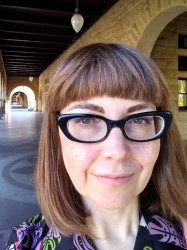Summary
Karyn Chappell has returned to Imperial College London after a 2 year Postdoctoral Scholarship in Orthopaedic Surgery at Stanford University. Karyn joined the Department of Mechanical Engineering and is continuing the work from her PhD focusing on improving collagen imaging in knees whilst developing applications for imaging joints on a novel MRI extremity scanner with magic angle directional imaging (MADI).
Karyn graduated from King’s College London and rapidly found her niche working within the modality of MRI. Consolidating her understanding with a postgraduate qualification in MRI from Anglia Ruskin University. She has worked in numerous settings, including research and clinical trials, as well as private and NHS clinical work.
Her position as a research assistant on the transverse field MRI or "magic angle" scanner project had her developing the Magic Angle Directional Imaging (MADI) technique to scan patients when B0 moves. She worked with many varied disciplines to assist in developing this novel scanner.
Her PhD under the supervision of Dr Catherine Van Der Straeten, Professor Wladyslaw Gedroyc and Professor Donald McRobbie was associated with developing the applications for use on this novel scanner. For example, using the magic angle effect to visualise and quantify the health of the anterior cruciate ligament (ACL) of patients prior to unicondylar knee replacement. She hopes to continue to explore the potential of the magic angle effect in non-invasively detecting collagen changes that indicate cartilage damage in knees which have differing stages of osteoarthritis.
In her Postdoctoral position at Stanford University she continued to investigate the knee after ACL reconstruction to assess cartilage / bone thickness and damage with qDESS and cones T2* UTE sequences. She developed a 'muscle quality' MRI protocol to measure and quantify changes in the thigh muscles after ACLR. She optimised the ZTE scans and post processing to assess tunnel placement reducing the need for CT scans in young ACL patients needing revision surgery. She was also involved with augmented reality surgical planning using a MS HoloLens 2 system in use at the VA hospital in Palo Alto. During Covid-19 she expanded her skills into pre-clinical imaging including bioluminescent imaging of MSC as well as microCT, DEXA and ultra-high field MRI of knee joint specimens.
Publications
Journals
Mills L, Chappell KE, Emsley R, et al., 2024, Preterm Formula, Fortified or Unfortified Human Milk for Very Preterm Infants, the PREMFOOD Study: A Parallel Randomised Feasibility Trial., Neonatology, Vol:121, Pages:222-232
Lanz H, Ristic M, Chappell K, et al., 2023, Minimum number of scans for collagen fibre direction estimation using Magic Angle Directional Imaging (MADI) with a priori information, Array, Vol:17, ISSN:2590-0056, Pages:1-10
Brujic D, Chappell KE, Ristic M, 2020, Accuracy of collagen fibre estimation under noise using directional MR imaging, Computerized Medical Imaging and Graphics, Vol:86, ISSN:0895-6111, Pages:1-9
Chappell K, Brujic D, Van Der Straeten C, et al., 2019, Detection of maturity and ligament injury using magic angle directional imaging, Magnetic Resonance in Medicine, Vol:82, ISSN:0740-3194, Pages:1041-1054

